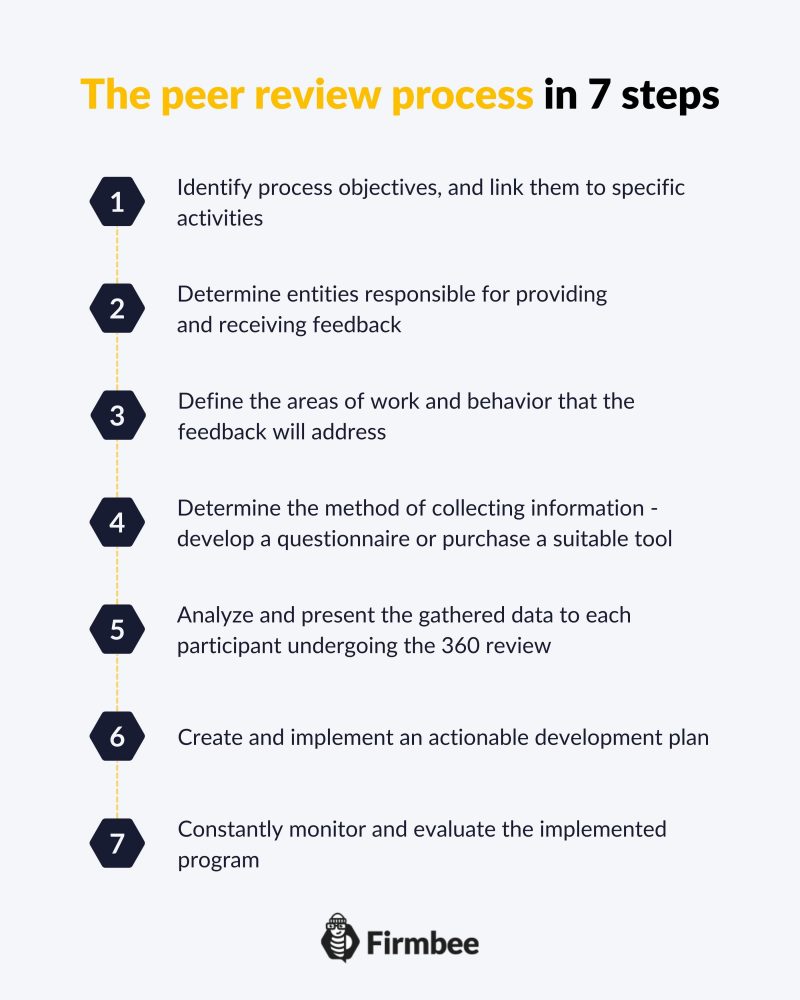What is peer-to-peer feedback? Peer-to-peer feedback in the workplace is a new performance review model. In the HRM practice, it is also often referred to as 360 degree feedback. Organizations looking to optimize operations and reduce costs, increasingly appreciate the importance of the peer review. Managers are responsible for the implementation of peer feedback, however, in order for the process to be successful, it is necessary to involve the entire staff in it, regardless of occupied positions. All employees should be open to the feedback from their supervisors and coworkers, as well as internal and external clients. Read our article to learn more about the process.
Peer-to-peer feedback- table of contents:
- What is peer-to-peer feedback?
- The peer review process in 7 steps
- The pros and cons of 360 degree feedback
- Summary
What is peer-to-peer feedback?
Peer-to-peer review is a process in which an individual takes feedback from multiple sources such as supervisors, colleagues, as well as internal and external clients. Therefore, it is also often called a multi-source feedback. This assessment technique is usually implemented to:
- support employee learning and development,
- help with employee acquisition and succession planning,
- make smart pay decisions, especially with regard to bonuses and rewards.
The peer review process in 7 steps
The peer review process is based primarily on questionnaires. They make it possible to measure various behaviors of individuals in relation to a list of competencies. Competencies may refer to leadership, individual positions occupied by team members, self-directed learning, communication, organizational skills, decision-making, knowledge, and motivation.
Assessments are conducted by feedback providers who assign a grade on an appropriate scale. Questionnaires are usually completed anonymously as it is determined by organizational culture.The obtained information will contribute to specific actions depending on the set objective.
How to implement 360 degree feedback properly?
Follow these steps:
- identify process objectives, and link them to specific activities,
- determine entities responsible for providing and receiving feedback,
- define the areas of work and behavior that the feedback will address,
- determine the method of collecting information – develop a questionnaire or purchase a suitable tool,
- analyze and present the gathered data to each participant undergoing the 360 review,
- create and implement an actionable development plan,
- constantly monitor and evaluate the implemented program.
The success of peer-to-peer feedback depends primarily on the approval of supervisors and those who participate in the process. It requires the direct involvment of all employees. It is also important that the content of the questionnaire reflects typical and meaningful aspects of behaviour and relates to actual events.
It should be noted that participants must not feel threatened in any way. This can be avoided through the anonymity of the questionnaire, which should be short and simply worded.

The pros and cons of 360 degree feedback
| Pros | Cons |
| It gives employees the opportunity to learn how they are perceived by others. | It provides subjective information that is not based on truth or facts. |
| It makes managers aware of the necessity to train employees. | It induces stress in feedback providers and employees undergoing the process. |
| It helps to reinforce desired competencies. | It forces companies to create unnecessary procedures. |
| It identifies areas for improvement and development. | It’s time consuming and unreliable. |
| It determines the strenghts and weaknesses of the organization. | It requires investment and commitment. |
| It helps to learn the true value of key employees. | It might make employees feel intimidated by fellow workers who speak negatively about them. |
Summary
The aim of 360 degree feedback is to provide employees with a well-rounded view of their performance, which lets them develop leadership skills and enhance productivity. It also helps workers achieve greater efficiency as it points directly to areas that need improvement . For peer-to-peer feedback to be effective, you should discuss the entire implementation process with all participants, and present its benefits to them.
You’ve just learned what peer-to-peer feedback is. Other resources: Benefits and challenges of globalization.
If you like our content, join our busy bees community on Facebook, Twitter, LinkedIn, Instagram, YouTube, Pinterest.
Author: Nicole Mankin
HR manager with an excellent ability to build a positive atmosphere and create a valuable environment for employees. She loves to see the potential of talented people and mobilize them to develop.















